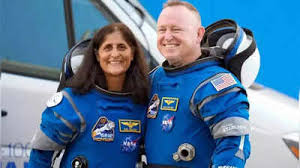Astronaut Butch Wilmore retires from NASA after spending extended 9 months in space

August 7, 2025 | Washington, D.C.:
NASA astronaut Barry “Butch” Wilmore, one of the most experienced and respected figures in modern space exploration, has officially retired from the space agency. His decision comes shortly after completing an extraordinary nine-month mission aboard the International Space Station (ISS), closing a remarkable chapter in a career that spanned decades.
The 62-year-old astronaut has left behind a legacy of bravery, service, and scientific achievement. With more than 640 days spent in space across multiple missions, Wilmore retires as one of the most seasoned astronauts in NASA’s history.
An Unprecedented Mission in Space
Wilmore’s final mission, which lasted approximately 270 days, was one of the longest missions by a U.S. astronaut aboard the ISS. This extended stay wasn’t just about breaking records — it was a crucial step in helping NASA prepare for future deep space missions, particularly those under the Artemis program and the long-term goal of reaching Mars.
During his nine months in orbit, Wilmore was at the forefront of several scientific and engineering experiments. These included tests related to muscle and bone deterioration in microgravity, psychological resilience in confined environments, and trials involving next-generation space technologies. All of these are vital to understanding how humans can live and work in space for extended periods — a necessity for journeys that could take years.
“Staying in space for nine months wasn’t easy,” Wilmore said during a post-landing interview. “But when you know you’re helping humanity prepare for a new era of exploration, it makes every challenge worth it.”
From Naval Aviator to Space Pioneer
Before joining NASA, Wilmore served as a decorated naval aviator and test pilot. His military background, coupled with his engineering expertise, made him an ideal candidate for space missions that required precision, endurance, and leadership under pressure.
He was first selected by NASA in 2000 and made his initial trip to space aboard Space Shuttle Atlantis in 2009. He returned to space again in 2014, this time serving as commander of Expedition 42 aboard the ISS. Across his career, he completed four spacewalks, clocking more than 25 hours working outside the station in the vacuum of space.
His final mission, launched in 2024, not only tested new living conditions but also challenged the human spirit — demanding physical stamina and mental resilience in one of the most isolated environments known to man.
A Symbol of Steady Leadership
Wilmore’s colleagues at NASA often described him as calm, disciplined, and unwavering in the face of uncertainty. His leadership during the recent mission became even more crucial when the crew faced unexpected technical challenges related to onboard life support and communication systems. According to mission reports, Wilmore’s quick decision-making and deep understanding of spacecraft systems played a key role in maintaining mission stability.
NASA Administrator Bill Nelson paid tribute to Wilmore’s legacy, saying,
“Butch Wilmore has shown us what it means to be a true explorer. His contributions to science, his leadership in space, and his mentorship on Earth will be remembered for years to come.”
In addition to his space duties, Wilmore frequently worked with new astronaut candidates, sharing his experience and training them in mission-critical operations. He was also a vocal advocate for increased international collaboration in space science and engineering.
A Lasting Impact on NASA and Beyond
Throughout his career, Wilmore remained deeply committed to science education and public outreach. He participated in countless virtual classroom sessions from space, inspiring thousands of students around the world. His belief in the power of exploration extended beyond the technical — he often spoke about space as a shared human frontier, not just a national achievement.
His retirement doesn’t mean he’s stepping away from space altogether. According to sources close to the astronaut, Wilmore is expected to take on advisory roles, particularly in the field of astronaut training and mission planning for long-duration flights. He is also rumored to be involved in a future initiative aimed at promoting STEM education through interactive platforms and real-life mission simulations.
Preparing the Next Generation
As NASA sets its sights on returning to the Moon and eventually sending humans to Mars, the experience and data gathered from Wilmore’s nine-month mission will prove invaluable. His feedback on mental and physical health, resource management, and daily routines aboard the ISS are already influencing how future astronauts will live and work on lunar outposts and Mars-bound spacecraft.
In a farewell message to his team, Wilmore wrote:
“I may be stepping away from the cockpit, but my heart will always be in the stars. It’s time for the next generation to carry the torch. I believe they’re ready.”
Conclusion
Butch Wilmore’s retirement marks the end of an inspiring era for NASA and the global space community. As the agency prepares to expand its reach further into the solar system, it does so on the foundation built by pioneers like Wilmore — individuals whose courage and determination bring humanity one step closer to becoming an interplanetary species.
From his first launch to his final reentry, Wilmore exemplified the core values of exploration: curiosity, endurance, and the relentless pursuit of progress. His legacy will not only be measured in time spent in space, but in the lives he’s touched and the missions he’s made possible.






